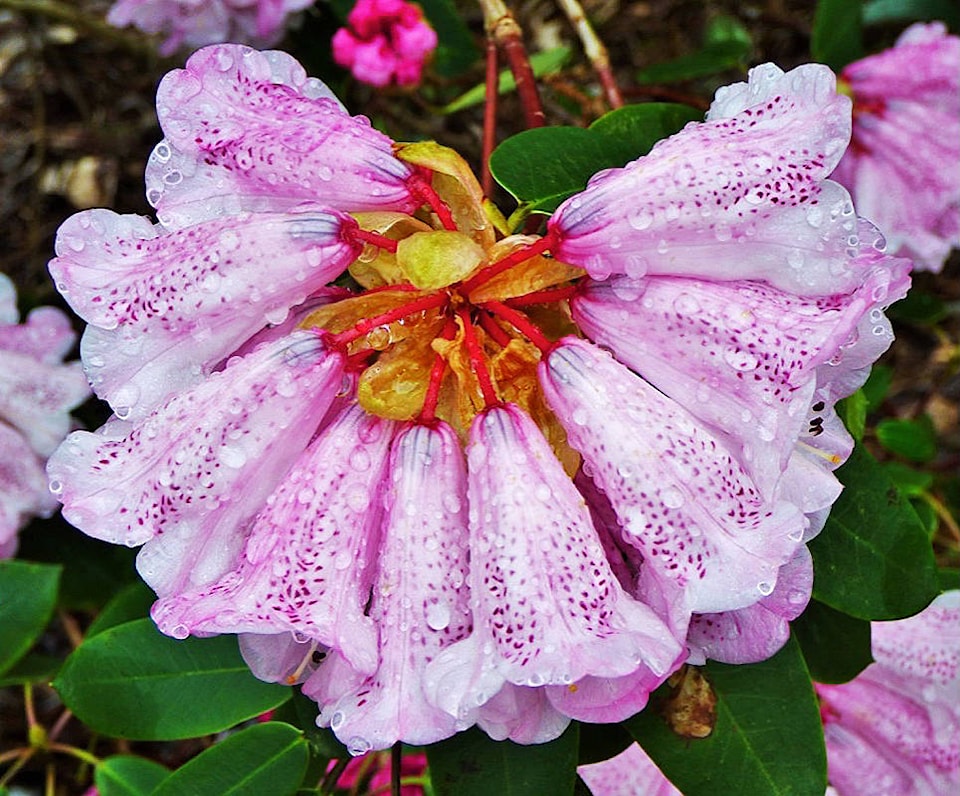I have known Rose Grabenhorst and her garden for about 20 years now, as she lives just around the corner from the nursery where I work.
She dropped by recently and mentioned that many of her seedling rhododendrons were finally maturing and blooming this year, so I decided to stop by and see her handiwork.
Rose gave me the full tour, which takes some time, as she cares for five acres, which are planted quite intensively.
Of course, it wasn’t always a show garden. Back in 1979, when she first moved here, there was nothing but horse pasture.
In 1985, she started planting Christmas trees, with it eventually morphing into a full-fledged botanical garden.
I mean this with all sincerity, as her landscape is full of rarities such as Japanese umbrella pine (Sciadopitys verticillata), Chinese fir (Cunninghamia) and bald cypress (Taxodium), which love the swampy conditions in the back ’40, as evidenced by the abundance of knobby knee roots bursting out of the ground.
Even though the weather has been unseasonably cool, her garden is still full of colour, with pale yellow winter hazels (Corylopsis), flowering quince and rather weedy drifts of ranunculus all in full bloom.
Dispersed throughout the landscape are her pride and joy, the rhododendrons that she grew from seed and which are finally flowering after seven to eight years of waiting.
It is quite a diverse collection, with white to shell pink and deep rose trusses, some quite large and others hanging in pendulous clusters with spotting both inside and out.
There are obviously some species rhododendrons, such as R. calophytum or R. fortunei in the breeding mix.
But since Rose just gathered the mature seed pods, we have no way of knowing – which makes the wait all the more interesting.
She also has dozens of rhododendron cultivars on site, so the potential for some interesting crosses is likely.
These natural hybrids currently range from four to 12 feet tall, with foliage that varies from matte to glossy, some with tortoiseshell veining and others with light indumentum or plant hairs on the reverse.
A few of them have leaves longer than 12 inches and the trusses can be lax with bell-shaped blooms or upright, with white flowers showing a distinct burgundy blotch.
All are quite beautiful and come from humble circumstances, as Rose showed me her next crop of seedlings sitting on a side table in the house next to the window, happily growing in old clear plastic deli trays - carefully brought into existence by a gardener who swears to me that she has no room left to plant, yet who always seems to find a beckoning void.
That devotion has resulted in one of Pitt Meadows’ most interesting show gardens, with something to catch the eye around every bend.
Of course, if you don’t want to wait the time that Rose did to see your new rhododendrons in bloom, then now is a good time to visit your local garden centre and purchase a few of your own.
I would highly recommend ‘Nancy Evans’ (bright yellow), ‘Polarnacht’ (the deepest purple), ‘Medusa’ (orange), ‘Besse Howells’ (frilled raspberry-red), ‘Honey Butter’ (yellowish-orange with pink) and ‘Cherry Cheesecake’ (pale pink with a red blotch) if showy colours are important to you.
More compact selections would include ‘Purple Gem’, ‘Patty Bee’ (pale yellow) or ‘Baden-Baden’ (bright red), which fit into smaller condominium or townhouse gardens nicely.
For those of you with existing specimens, don’t forget to feed them with a rhododendron and azalea fertilizer at least twice a year, just before flowering and after they fade.
Mike Lascelle is a local
nursery manager
and gardening author
(hebe_acer@hotmail.com).
